
Larousse Gastronomique is an encyclopedia of gastronomy. The majority of the book is about French cuisine, and contains recipes for French dishes and cooking techniques. The first edition included few non-French dishes and ingredients; later editions include many more. The book was originally published by Éditions Larousse in Paris in 1938.

Seasoning is the process of supplementing food via herbs, spices, salts, and/or sugar, intended to enhance a particular flavour.
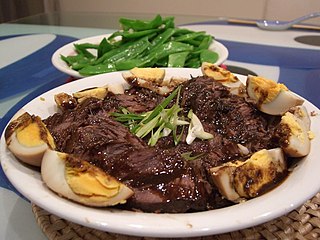
Braising is a combination-cooking method that uses both wet and dry heats: typically, the food is first browned at a high temperature, then simmered in a covered pot in cooking liquid. It is similar to stewing, but braising is done with less liquid and usually used for larger cuts of meat. Braising of meat is often referred to as pot roasting, though some authors make a distinction between the two methods, based on whether additional liquid is added. Osso buco and coq au vin are well known braised meat dishes, and the technique can be used to prepare fish, tempeh, tofu or fruits and vegetables.

Fines herbes designates an important combination of herbs that forms a mainstay of French cuisine. The canonical fines herbes of French haute cuisine comprise finely chopped parsley, chives, tarragon, and chervil. These are employed in seasoning delicate dishes, such as chicken, fish, and eggs, that need a relatively short cooking period; they may also be used in a beurre blanc sauce for seasoning such dishes. Fines herbes are also eaten raw in salads.
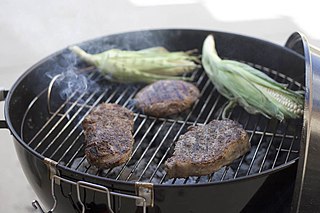
A barbecue grill or barbeque grill is a device that cooks food by applying heat from below. There are several varieties of grills, with most falling into one of three categories: gas-fueled, charcoal, or electric. There is debate over which method yields superior results.
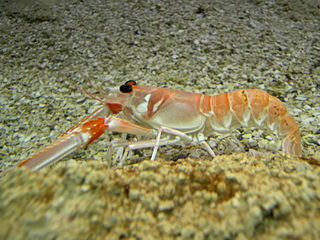
Scampi, also called Dublin Bay Prawn or Norway Lobster, is an edible lobster of the order Decapoda. It is widespread in the Mediterranean and northeastern Atlantic, from North Africa to Norway and Iceland, and is a gastronomic delicacy. Scampi became the only species in the genus Nephrops after several other species were moved to the closely related genus Metanephrops.

A kettle, sometimes called a tea kettle or teakettle, is a type of pot specialized for boiling water, commonly with a lid, spout, and handle, or a small electric kitchen appliance of similar shape that functions in a self-contained manner. Kettles can be heated either by placing on a stove, or by their own internal electric heating element in the appliance versions. As indicated by its name, the kettle was and is often used as teaware to brew tea or prepare a tisane. Some very modern versions do more than just boil water, and also make the tea and keep it warm.

A quenelle is a mixture of creamed fish or meat, sometimes combined with breadcrumbs, with a light egg binding, formed into an egg-like shape, and then cooked. The usual preparation is by poaching. Formerly, quenelles were often used as a garnish in haute cuisine. Today, they are more commonly served sauced as a dish in their own right. Similar items are found in many cuisines.
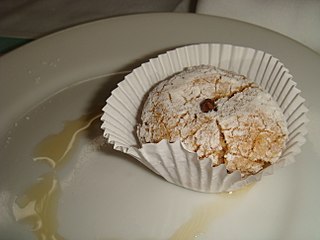
Quatre épices is a spice mix used mainly in French cuisine, but can also be found in some Middle Eastern kitchens. Its name is French for "four spices"; it is considered the French allspice. The spice mix contains ground pepper, cloves, nutmeg and dried ginger. Some variations of the mix use allspice or cinnamon instead of pepper, or cinnamon instead of ginger.

Daube is a classic Provençal stew made with inexpensive beef braised in wine, vegetables, garlic, and herbes de Provence, and traditionally cooked in a daubière, a braising pan. A traditional daubière is a terracotta pot that resembles a pitcher, with a concave lid. Water is poured on the lid, which condenses the moisture inside, allowing for the long cooking required to tenderize lesser cuts of meat. The meat used in daube is cut from the shoulder and back of the bull, though some suggest they should be made from three cuts of meat: the "gelatinous shin for body, short ribs for flavor, and chuck for firmness." Although most modern recipes call for red wine, a minority call for white, as do the earliest recorded daube recipes.

Beef bourguignon or bœuf bourguignon, also called beef Burgundy, and bœuf à la Bourguignonne, is a French beef stew braised in red wine, often red Burgundy, and beef stock, typically flavored with carrots, onions, garlic, and a bouquet garni, and garnished with pearl onions, mushrooms, and bacon. A similar dish using a piece of braised beef with the same garnish is pièce de bœuf à la bourguignonne.

Court-bouillon or court bouillon is a quickly-cooked broth used for poaching other foods, most commonly fish or seafood. It is also sometimes used for poaching vegetables, eggs, sweetbreads, cockscombs, and delicate meats. It includes seasonings and salt but lacks animal gelatin.

A floating island or île flottante is a dessert consisting of meringue floating on crème anglaise. The meringue is prepared from whipped egg whites, sugar, and vanilla extract and baked in a bain-marie. The crème anglaise is prepared with the egg yolks, vanilla, and hot milk, briefly cooked.

Gratin is a culinary technique in which an ingredient is topped with a browned crust, often using breadcrumbs, grated cheese, egg or butter. The term may be applied to any dish made using this method. Gratin is usually prepared in a shallow dish of some kind. A gratin is baked or cooked under an overhead grill or broiler to form a golden crust on top and is often served in its baking dish.
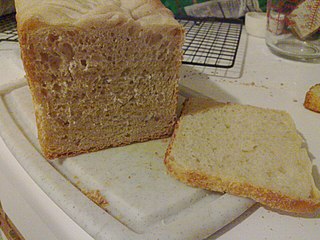
The Pullman loaf, sometimes called the "sandwich loaf" or "pan bread", is a rectangular loaf of white bread baked in a long, narrow, lidded pan. The French term for this style of loaf is pain de mie, or, less commonly, pain anglais.
A cassolette is a small porcelain, glass, or metal container used for the cooking and serving of individual dishes. The word also refers to dishes served in such a container:

Méchoui or Meshwi is a whole sheep or lamb spit-roasted on a barbecue in Maghrebi cuisine. The word comes from the Arabic word šawā. This dish is very popular in North Africa.
















